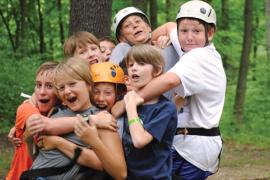Campers and staff have equal opportunity to be injured at camp because they spend their days, (and in resident camps, their nights) engaged in the same activities of camp life. Since they are exposed to the same risks, they experience similar patterns of injury. The exceptions of course are kitchen and maintenance staff members, who are engaged in other risky activities.
ACA’s Healthy Camp Study, which monitored results from participating camps from 2006–2010, reported that campers and staff from both resident and day camps experienced a relatively low rate of injury when compared to certain youth sports activities. This is obviously good news.
Campers were injured slightly more frequently than staff. Gender didn’t play a part in how often campers were injured, but female staff members were more likely to be injured than male staff at day and resident camps. The reason for this was not apparent in the study. What is your experience? Was this an anomaly in the study, or do you think this may be a valid pattern?
The Healthy Camp Study identified factors that contributed to staff injuries. Experienced camp directors will agree with these and perhaps add some others as well. Why do camp employees get hurt? The following list of factors is a compilation — in no particular priority — based upon the Healthy Camp Study and experience.
Unsafe and Improper Actions
Ever catch yourself saying, “Why did he (or she) do that?” This reaction often follows hearing about or observing unsafe staff behavior that results in a near miss or an injury. Very often, judgment was lacking, and in other cases, there was a near-complete lack of understanding of the risks involved. Close your eyes for a moment and remember that incident from the summer when . . . Oh, too scary — sorry! Let’s call this failure to think and anticipate consequences.
“Gray” Period Athletic Injuries
“Gray” period athletic injuries occur when staff members have time off between periods during the day at day camps, or are on a day off at resident camp. The injuries often involve reinjuring a body part (ankle, knee, hand, wrist, finger), that might have been prevented if the employee had used a previously prescribed protective device — such as a knee brace, for example — after the first injury.
Besides the failure to use personal protective equipment, the root cause of these ath¬letic injuries often involves failure to warm up, over use, over exuberance, or misuse of equipment. By the way, “gray” period athletic injuries sustained by staff are most likely not covered by workers compensation insurance. Do you require staff to have health insurance, or does your camp provide protection for them under an accident medical insurance policy?
Horseplay with Campers
Anyone with siblings knows horseplay is a part of daily life, and horseplay at camp is certainly no different. Some experienced directors might also say horseplay is an inherent risk that can be managed but not eliminated.
Every summer, someone (a camper or staff member) is injured when horseplay fun goes too far. Knowing when and how to stop the horseplay before injury is a key decision-making skill. How do you manage horseplay behavior at your camp? Have employees been injured? What skills do they need to protect themselves and campers from horseplay injury?
Inadequately Maintained Equipment and Conditions Inherent in the Premises
The Healthy Camp Study reported slips, trips, and falls as major sources of injuries. Inappropriate footwear (e.g., flip flops for basketball or hiking rough trails in open-toed sandals) was cited as an underlying factor contributing to these injuries.
Other places where staff may slip, trip, and fall include swimming pools, showers, kitchens, ropes courses, hiking trails, sports fields, porches, and decks. Conditions inherent in the premises may be contributing factors. Liquid spills in the kitchen present a slipping hazard; wear and tear on zip line cables, carabineers, and pulleys present a fall risk from height; woodchuck holes in playing fields, which sometimes seem to appear overnight, can result in nasty injuries if you step in them while running. Risk is constantly changing — that is why risk management requires a critical thought process and discerning judgment.
Fatigue
It is well known that fatigue contributes to accidents and injuries. The ACA Healthy Camp study urged staff to take care of themselves to reduce the risk of illness. Let’s reiterate this statement for reducing the risk of injury. Fatigue is a wicked culprit because tiredness sneaks up on you during a particularly hot or long, busy day.
Fatigue lingers and grows so the risk of injury may actually increase as the summer wears on. It is especially important for staff engaged in higher risk activities to have respite and down time to reduce the risk of serious injury in the activities they supervise.
What is your strategy for avoiding the consequences of staff fatigue?
Failure to Wear Proper Footwear
Failure to wear proper footwear was an issue in the Healthy Camp Study. Although not explicitly stated, this injury factor should also include failure to wear footwear properly, and failure to wear footwear at all!
Staff members need guidance on this issue. The Healthy Camp Study revealed that 40–50 percent of the injuries to staff at day and resident camp were to the lower extremities. The most common injury was a sprain caused by a slip, trip, or fall.
Wearing the right shoes properly to protect toes, feet, and ankles would go a long way to reducing the risks of injury from just the normal activities of walking and running at camp. Bringing specialty shoes such as footwear needed by maintenance and kitchen staff (boots with steel toes and shanks, and closed heel and toe shoes with non-skid/non-slip soles) may not be a priority because of travel and space limitations.
Considering the varied activities staff members engage in during the summer, the list of footwear needed for camp defi¬nitely requires some forethought. What guidance do you provide your staff about proper footwear?
Failure to Wear Personal Protective Equipment (PPE)
This factor is a contributor to “gray” period athletic injuries already mentioned. While this injury factor contributes to plenty of sprained ankles and torn ACLs, it can have potentially fatal consequences. Every summer we hear about many boating fatalities on lakes and rivers during recreational activities among the general public. These deaths could have been prevented with the proper use of a personal flotation device (PFD). Unfortunately, there is a history of fatalities in camp programs for the same reason.
Besides not wearing PFDs, staff members fail to wear seat belts, helmets, eye and ear protection, and, yes, proper footwear at various times. It is hard to imagine this short-sightedness in light of precamp training and ACA standards. But, failure to wear PPE was cited as a significant contributing factor to staff injuries in the Healthy Camp Study data — so much so that an online course to raise awareness was developed and made available even before the study’s final report. (The course is available at www.ACAcamps.org/einstitute/healthycamp.)
Why do staff members behave this way? Is it over-confidence, inexperience, inability to foresee consequences, or some combination of these? Or is there something else at work? What can you do at your camp to ensure staff members
always use PPE?
Improper Handling of Knives in the Kitchen and Elsewhere
Data indicating kitchen staff suffered injuries (hopefully just cuts to hands and fingers) from the use of knives was not as surprising as when other staff also reported injuries while using knives. What are we to conclude from this information? Did we assume everyone got some training on how to work with knives as a scout, a camper, from their parents, or grandparents at some point during their formative years? If so, that assumption was basically wrong. Is the root cause of staff injuries while using knives the result of no training, careless¬ness (think failure to use PPE), or due to false assumptions about staff skills with knives? What do you think?
Is There a Common Thread in Staff Injuries?
What is the root cause of staff injuries? Is it thoughtlessness or carelessness? Is training deficient, or are assumptions about staff skills incorrect? Are injuries due to inexperience and youth? What would happen to the frequency and severity of staff injuries if we improved their ability to think and make better choices? What’s the payback if we invest in staff and help them develop the critical thinking needed to improve their own choices and decision making at camp? Priceless.
Edward A. Schirick, C.P.C.U., C.I.C., C.R.M., is senior vice president at Schirick & Associates Insurance Brokers, a division of Bollinger Inc. in Short Hills, New Jersey, where he specializes in arranging insurance coverage and offering risk management advice for camps. Schirick is a chartered property casualty underwriter, a certified insurance counselor, and a certified risk manager. He can be reached at 877-794- 3113. Visit www.campinsurancepro.com.
Originally published in the 2011 November/December Camping Magazine.


